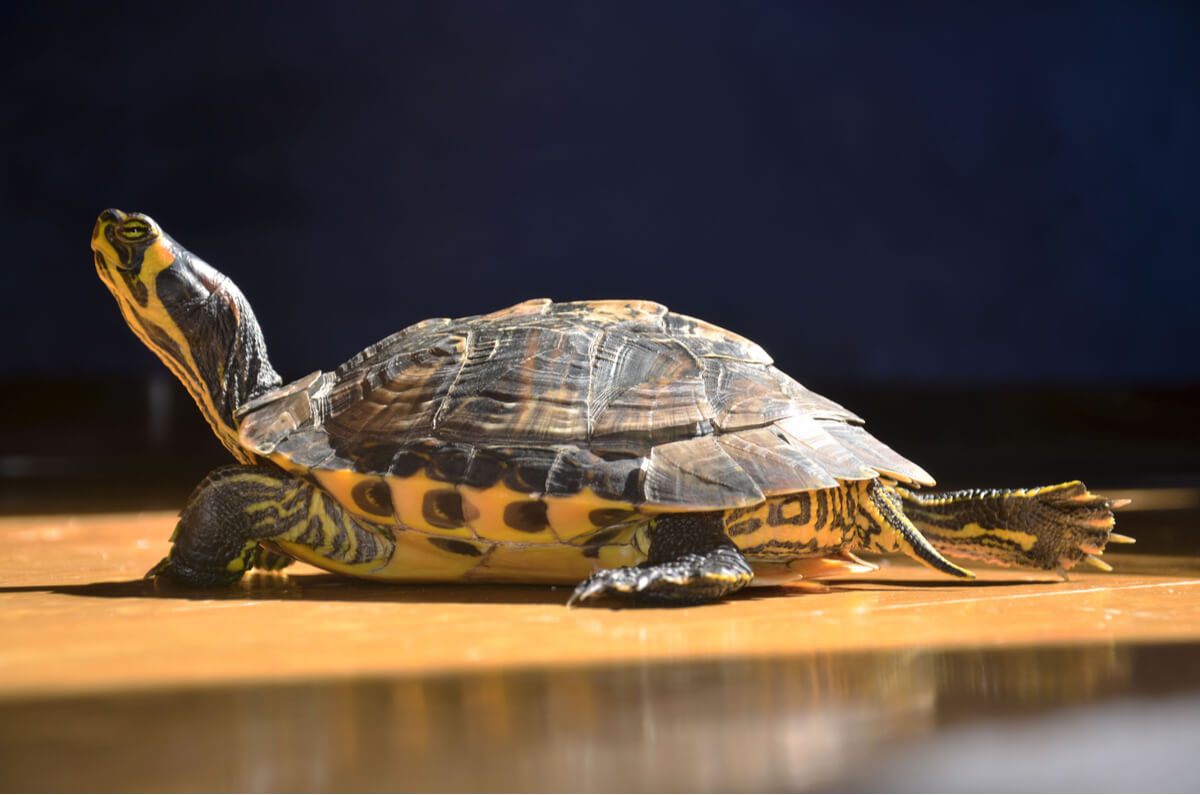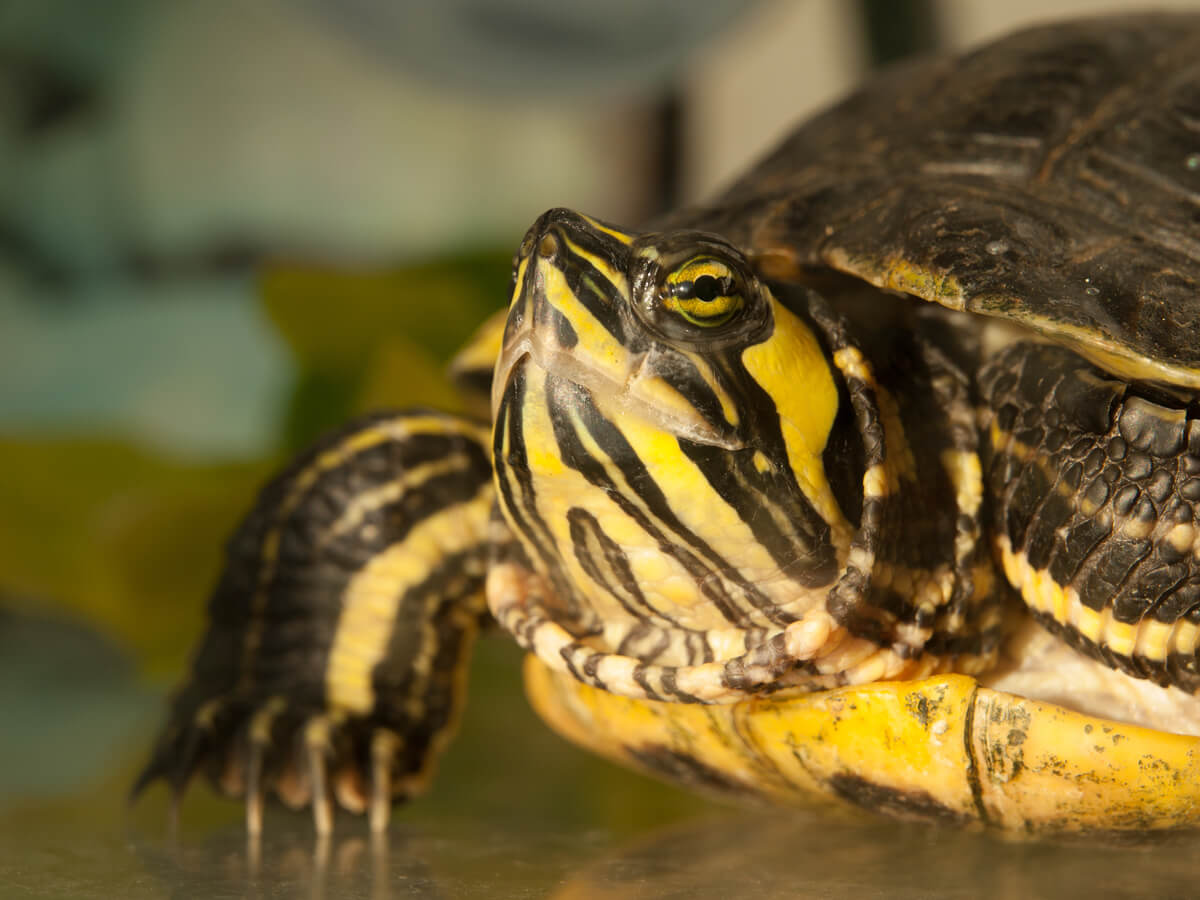What Do Aquatic Turtles Eat?


Written and verified by the biologist Cesar Paul Gonzalez Gonzalez
Turtles are characterized by a hard shell that protects them from predators. In addition, they’re animals that have colonized both water and land, and so they enjoy good success in conquering new habitats. Thanks to their charismatic and peculiar appearance, aquatic turtles are often adopted as pets, although it’s very common to wonder what aquatic turtles eat and other information about their feeding habits, and how to look after them.
Keep in mind that these reptiles have a fairly long longevity, and so if you decide to acquire one of them as a pet, you’ll have to make a long-term commitment. If you’ve decided you’d like to adopt one, then keep reading this article to find out all about what aquatic turtles eat and how best to feed them.
What are the needs of aquatic turtles?
Aquatic turtles don’t spend their whole lives in the water; they also make use of land to bask in the sun. For this reason, they should have a deep aquarium that has access to a basking area. This is important because, like other reptiles, they depend on UVB light to produce vitamin D and metabolize calcium.
In addition, these animals are ectotherms, which means that their environment must have a heat source to keep them warm. Therefore, the water temperature shouldn’t drop below 20 degrees Celsius (68 degrees Fahrenheit) or they may begin to have problems. Depending on where you live, you may (or may not) need to add a heater to meet your pet’s needs.
Finally, keep in mind that water quality is one of the most important factors for aquatic animals. Any dirt in the water could cause health problems for them. Consequently, a good filter shouldn’t be missing in order to keep the aquarium cleaner for a longer period of time. In addition, this also helps when feeding the turtles, as the food you supply them with can make their habitat even dirtier.

What do aquatic turtles eat?
Aquatic turtles are reptiles with a very varied omnivorous diet. However, the type of food changes according to their age, and, in some cases, they must be fed certain foods to support their development. In general, the recommended nutrition for these organisms according to their life stage is as follows:
- Young tortoises: These should be fed protein-rich foods (for carnivores) such as snails, worms, crickets, mealworms, waxworms, fish, and crustaceans. Some keepers also choose to feed them other types of food such as beef or cooked chicken, which isn’t a bad thing, but the habitat tends to get dirty faster.
- Adult tortoises: Adults can be fed the same food as young tortoises, but with the addition of herbs and plants to supplement their nutrition. In this case, the diet should be maintained with a minimum of 50% plant foods and a maximum of 25% protein.
Is pet feed good for turtles?
Special pet feed is a good option for supplementing an aquatic turtle’s diet. However, pet nutrition shouldn’t only be based on this type of food, as reptiles need a varied diet to stay healthy. The best option is to use the feed, but mix it with live food and plants to balance their nutrients at the same time.
Can I give insects to my turtles?
Turtles eat insects in their natural environment and these are used as a regular component of their diet. In fact, it’s easy to get this type of live food at specialty pet or reptile stores. Common arthropods include crickets, worms, and the larvae of some beetles. Remember that protein shouldn’t exceed 25% of their total food.
Can I give live fish to my turtles?
Fish are part of the natural diet of these reptiles, so they can sometimes be fed with them. To do this, they’re often offered some live specimens, such as charales (Chirostoma). In addition to feasting on them, the turtles get some exercise while chasing them in their habitat.
Some keepers choose to offer dead fish to their turtles. However, this often leads to a problem with the reptile’s hygiene. Also, remember that, in these cases, the food shouldn’t contain any additives or preservatives, as these are harmful compounds.
Can I give raw meat to my turtles?
Raw meat can be an option if you want to vary your turtle’s diet. However, there’s a downside to the cleanliness of the habitat when feeding raw meat. This is because it dirties the water faster, meaning it has to be changed more frequently. For this reason, even though it may seem a good idea, it’s better to leave it as a last resort.
What vegetables can turtles eat?
Plants are a fundamental component of this reptile’s diet, as they provide them with various vitamins and minerals that are necessary for their health. For this reason, plant-based food should make up 50% of their diet in order to provide them with sufficient nutrients. Some of the vegetables and plants most commonly used in turtle food are as follows:
- Turnips
- Beans
- Carrots
- Bananas
- Melons
- Fresh fruits
- Dandelions (Taraxacum officinale)
- Romaine lettuce
- Cabbage
- Mustard greens
- Aquatic plants (such as Elodea and water lily)
Food supplements
Although the diet should be sufficient to supply all the nutrients the tortoise needs, it may need calcium and vitamin supplements. These compounds aren’t necessary in all cases and should only be given on prescription from a veterinarian. Keep in mind that too many of these components in reptile nutrition can also affect their health.
How often should I feed my turtle?
Young aquatic turtles should be fed high-protein food on a daily basis. Adult turtles can be fed 3 to 4 times a week with a ratio of 25% protein to 50% vegetables.
The best recommendation is to feed the turtles in the same aquarium without repositioning them, as handling causes stress that can be detrimental.

Most reptiles are solitary and independent and require little care, as they don’t like handling. Try to respect their space, as stress can cause them serious health problems. Each pet has specific needs, so make sure you meet each of them before you acquire one.
Turtles are characterized by a hard shell that protects them from predators. In addition, they’re animals that have colonized both water and land, and so they enjoy good success in conquering new habitats. Thanks to their charismatic and peculiar appearance, aquatic turtles are often adopted as pets, although it’s very common to wonder what aquatic turtles eat and other information about their feeding habits, and how to look after them.
Keep in mind that these reptiles have a fairly long longevity, and so if you decide to acquire one of them as a pet, you’ll have to make a long-term commitment. If you’ve decided you’d like to adopt one, then keep reading this article to find out all about what aquatic turtles eat and how best to feed them.
What are the needs of aquatic turtles?
Aquatic turtles don’t spend their whole lives in the water; they also make use of land to bask in the sun. For this reason, they should have a deep aquarium that has access to a basking area. This is important because, like other reptiles, they depend on UVB light to produce vitamin D and metabolize calcium.
In addition, these animals are ectotherms, which means that their environment must have a heat source to keep them warm. Therefore, the water temperature shouldn’t drop below 20 degrees Celsius (68 degrees Fahrenheit) or they may begin to have problems. Depending on where you live, you may (or may not) need to add a heater to meet your pet’s needs.
Finally, keep in mind that water quality is one of the most important factors for aquatic animals. Any dirt in the water could cause health problems for them. Consequently, a good filter shouldn’t be missing in order to keep the aquarium cleaner for a longer period of time. In addition, this also helps when feeding the turtles, as the food you supply them with can make their habitat even dirtier.

What do aquatic turtles eat?
Aquatic turtles are reptiles with a very varied omnivorous diet. However, the type of food changes according to their age, and, in some cases, they must be fed certain foods to support their development. In general, the recommended nutrition for these organisms according to their life stage is as follows:
- Young tortoises: These should be fed protein-rich foods (for carnivores) such as snails, worms, crickets, mealworms, waxworms, fish, and crustaceans. Some keepers also choose to feed them other types of food such as beef or cooked chicken, which isn’t a bad thing, but the habitat tends to get dirty faster.
- Adult tortoises: Adults can be fed the same food as young tortoises, but with the addition of herbs and plants to supplement their nutrition. In this case, the diet should be maintained with a minimum of 50% plant foods and a maximum of 25% protein.
Is pet feed good for turtles?
Special pet feed is a good option for supplementing an aquatic turtle’s diet. However, pet nutrition shouldn’t only be based on this type of food, as reptiles need a varied diet to stay healthy. The best option is to use the feed, but mix it with live food and plants to balance their nutrients at the same time.
Can I give insects to my turtles?
Turtles eat insects in their natural environment and these are used as a regular component of their diet. In fact, it’s easy to get this type of live food at specialty pet or reptile stores. Common arthropods include crickets, worms, and the larvae of some beetles. Remember that protein shouldn’t exceed 25% of their total food.
Can I give live fish to my turtles?
Fish are part of the natural diet of these reptiles, so they can sometimes be fed with them. To do this, they’re often offered some live specimens, such as charales (Chirostoma). In addition to feasting on them, the turtles get some exercise while chasing them in their habitat.
Some keepers choose to offer dead fish to their turtles. However, this often leads to a problem with the reptile’s hygiene. Also, remember that, in these cases, the food shouldn’t contain any additives or preservatives, as these are harmful compounds.
Can I give raw meat to my turtles?
Raw meat can be an option if you want to vary your turtle’s diet. However, there’s a downside to the cleanliness of the habitat when feeding raw meat. This is because it dirties the water faster, meaning it has to be changed more frequently. For this reason, even though it may seem a good idea, it’s better to leave it as a last resort.
What vegetables can turtles eat?
Plants are a fundamental component of this reptile’s diet, as they provide them with various vitamins and minerals that are necessary for their health. For this reason, plant-based food should make up 50% of their diet in order to provide them with sufficient nutrients. Some of the vegetables and plants most commonly used in turtle food are as follows:
- Turnips
- Beans
- Carrots
- Bananas
- Melons
- Fresh fruits
- Dandelions (Taraxacum officinale)
- Romaine lettuce
- Cabbage
- Mustard greens
- Aquatic plants (such as Elodea and water lily)
Food supplements
Although the diet should be sufficient to supply all the nutrients the tortoise needs, it may need calcium and vitamin supplements. These compounds aren’t necessary in all cases and should only be given on prescription from a veterinarian. Keep in mind that too many of these components in reptile nutrition can also affect their health.
How often should I feed my turtle?
Young aquatic turtles should be fed high-protein food on a daily basis. Adult turtles can be fed 3 to 4 times a week with a ratio of 25% protein to 50% vegetables.
The best recommendation is to feed the turtles in the same aquarium without repositioning them, as handling causes stress that can be detrimental.

Most reptiles are solitary and independent and require little care, as they don’t like handling. Try to respect their space, as stress can cause them serious health problems. Each pet has specific needs, so make sure you meet each of them before you acquire one.
All cited sources were thoroughly reviewed by our team to ensure their quality, reliability, currency, and validity. The bibliography of this article was considered reliable and of academic or scientific accuracy.
- Wilke, H. (2010). Las tortugas. Editorial HISPANO EUROPEA.
- Castañeda Ortega, J. (2015). Tortugas acuáticas las mascotas del inframundo. Divulgación Acuícola, 14- 20.
- Wappel, S. M., & Schulte, M. S. (2004). Turtle care and husbandry. Veterinary Clinics: Exotic Animal Practice, 7(2), 447-472.
- Hamilton, L. (2015). Turtle. Weigl Publishers.
- Papeschi, C., & Sartini, L. (2013). Domestic turtles. Second part. Summa, Animali da Compagnia, 30(2), 39-51.
This text is provided for informational purposes only and does not replace consultation with a professional. If in doubt, consult your specialist.








